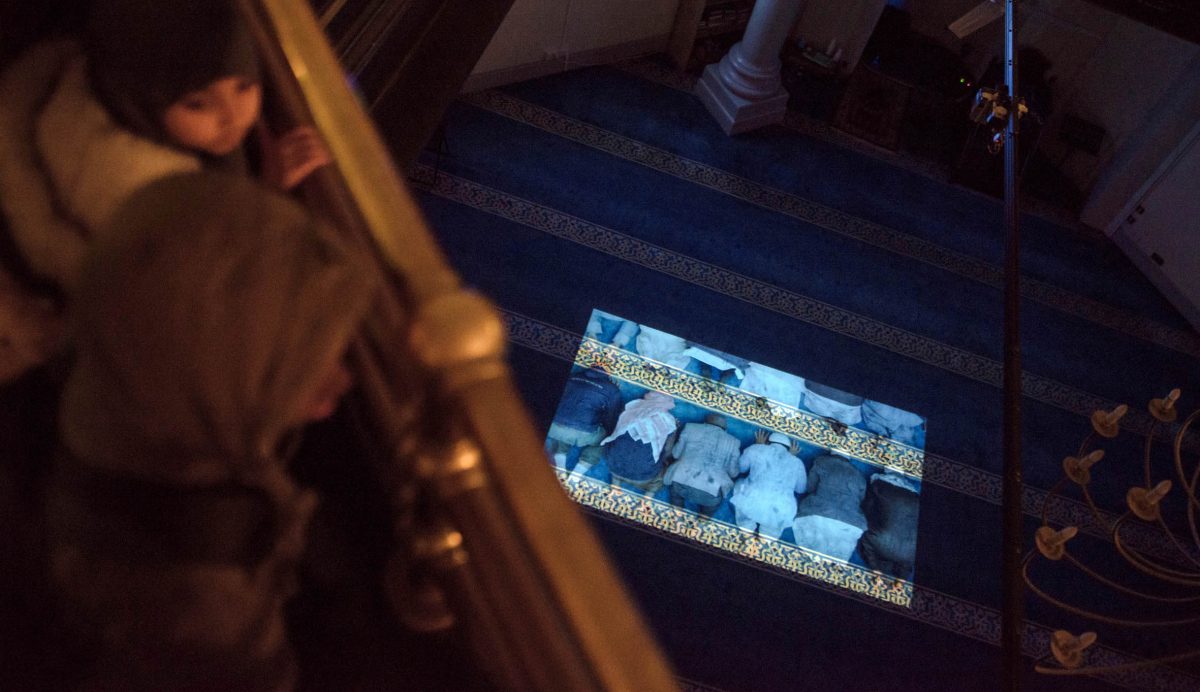
Image courtesy Julie Marsh
Assembly is a series of site-specific installations by artist Julie Marsh that perform the materiality of Muslim prayer spaces, comprising of 1:1 scaled moving floor projections of congregational prayer, with surround sound. Through its various iterations the project has provided a platform for various faith and community groups to build links and create a sense of solidarity. As a recent congressional member commented: “the projection opened my eyes to the physical act of prayer. Of movement and repetition. Because my view or senses are often fixed on a focal point (the imam), I didn’t really consider my own movements until seeing the image of myself in prayer.” [1]
For the Three British Mosques pavilion at the Venice Architecture Biennale 2021, Julie Marsh was commissioned by the V&A to extend her project and conduct a series of interviews with members of the congregation at Brick Lane Mosque, Old Kent Road Mosque and Harrow Mosque, allowing individual worshippers to tell their personal stories of their relationship with their own mosque. Alongside the interviews, extracts from the Assembly films of congregational prayer were also exhibited. Here we feature an extract from Julie Marsh’s contribution to the new publication British Mosques (Ed. Shahed Saleem, Christopher Turner and Ella Kilgallon), a collaboration between the Victoria and Albert Museum and the University of Westminster that seeks to capture the British mosque at a pivotal moment in its history.
This cinematic archive has its roots in research conducted for Assembly, a site-specific visual research project made and exhibited in Brick Lane Mosque, Old Kent Road Mosque and Harrow Mosque in London from 2018 to 2021. Made in collaboration with each mosque community, Assembly attempts to re-enact a performance of congregational prayer via 1:1 floor projections. An automated motorised camera is used to record the Jumu’ah (Friday) prayer from above; this film is then projected back on to the carpet on which the prayer was performed using a lens mounted on the same overhead track from which it was filmed. This projection – a record and a trace of worship – provides an opportunity for others to experience prayer in situ, via the artwork. At the end of each residency, the mosque community invites the general public into their prayer spaces to experience the Jumu’ah prayer via the site-performances.
Assembly uses the artist’s methodology of ‘site-integrity’ which employs artistic devices to perform the social, religious, architectural and institutional discourses taking place in a religious site. A mosque community is not a fixed entity, but is continually in the process of being made by the everyday practice of Islam. When sites of worship are reduced to representations, the performative and experiential qualities are lost. ‘Site-integrity’ repositions the act of representation from its retrospective or projective dimensions towards that which is experiential. Therefore, Assembly should not be regarded as a representation of a space, and still less one of individual worshipers, but rather as an attempt to perform the mosque as it actually exists. Both the buildings and the communities it forms are re-enacted each time the piece is performed, in a relational process between the site, worshippers, artwork and audience.
Julie Marsh, British Mosques, p111
British Mosques is co-published by Foolscap Editions and the V&A, 2021
http://foolscap-editions.com/british-mosques
Three Mosques Pavilion was on display at the Venice Architecture Biennale, 22 May – 21 November 2021 https://www.labiennale.org/en/architecture/2021/pavilion-applied-arts
[1] Marsh, J. 2018. Assembly: Performing the materiality of Muslim prayer spaces. Scene. 6 (2), pp. 133-151. https://doi.org/10.1386/scene_00014_1